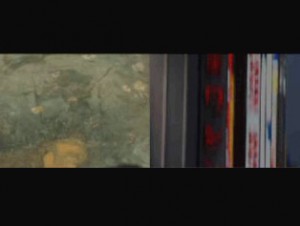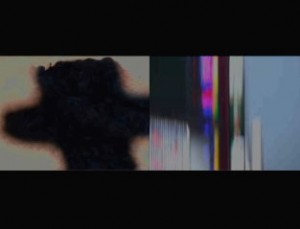Starting in 2001, Amerika began receiving international invitations to perform his Internet art works including two small national tours, one in Switzerland (Lucerne, Bern, and Basel) and one in Japan (Nagoya and three venues in Tokyo). This immediately set up a challenge for him since at the time of the invitations there were no preexisting models for performing one’s Internet art before a live audience. One major issue immediately emerged: “Why navigate through your Internet artworks before a live audience when the audience could just as easily navigate through these same sites themselves on their own time over the Internet?”
The answer was in what we would now call creative remixology (the subject of Amerika’s remixthebook). With no prior experience in live image manipulation and performance, Amerika began his international VJ Persona tour which lasted from the years 2001-2006. For these live A/V performances, Amerika taught himself new VJ [visual jockey] software that was just beginning to be developed by networked groups of artist-programmers who were frustrated with available commercial software. These “software art applications” were beginning to have a meaningful impact in the DJ and VJ culture which enabled digital performance artists to further blur the distinctions between high and low culture (the difference can be seen in Amerika performing the same work in a small techno-club space in Paris as well as the opening night of a museum exhibition in Tokyo).
Experimenting with these new software art applications, Amerika immediately began researching ways to remix the digital source material he had already captured for his major work of Net art, FILMTEXT. FILMTEXT was composed by reconfiguring a library of experimental digital video files, electronically composed sound files, and poetic texts that the artist had created especially for that project. These “assets” were archived in Amerika’s laptop studio in different file formats but were now going to be reformatted and deployed as multimedia data in his live A/V performances. Given the fact that FILMTEXT was developed as an abstract, multilinear narrative about “locating one’s self in the flow of data,” the ensuing remix of the work’s source material was ideally suited to both the live performances as well as Amerika’s scholarly investigations of subjectivity in both physical and data spaces (as well as hybrid or “(re)mixed reality” spaces). Each performance was completely improvised with a sound art collaborator and averaged 50 minutes in length. The venues varied and included the Museum for Communication in Bern, the Plug-In New Media Center in Basel, the International Symposium of Electronic Art in Nagoya, and the Machida City Museum of Graphic Arts in Tokyo.
These initial live A/V performances and the many others that followed in locations such as London, New York, San Francisco, and the Canary Islands, increasingly influenced both Amerika’s creative work trajectory as well as his theoretical writings like “Portrait of the VJ.”. The entire first section of META/DATA: A Digital Poetics (MIT Press, 2007), is a response to the experience of performing live with new media technologies. The imagery generated during these live performances made such an impact on Amerika’s creative research process that he was soon compelled to generate a series of digital prints made from stills of recorded events (these prints were later exhibited at the Rule Gallery in Denver and are now in private art collections). Perhaps even more importantly, these experiences led Amerika to conclude that he wanted to experiment with these digital processes in his various studio enviroinments and as a result, he immediately began constructing a new body of work conceived as digital video and surround sound installations (see CODEWORK and CHROMO HACK).


